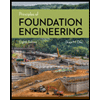2. The following laboratory data are available on the drained shear strength of a highly overconsolidated stiff clay at an effective normal stress range near 100 kPa: peak strength, c' = 10 kPa, o' = 22°; fully softened strength, c' = 0, o' = 21°; residual strength, c' = 0, 6; = 12°. Factor of safety for slope stability analysis is defined as F.S. (mobilized shear strength)/(shear stress). For one segment of a slip surface in a slope, the effective normal stress is 100 kPa and the factor of safety (for the segment) with respeet to peak strength is 1.7 %3D %3D %3!
2. The following laboratory data are available on the drained shear strength of a highly overconsolidated stiff clay at an effective normal stress range near 100 kPa: peak strength, c' = 10 kPa, o' = 22°; fully softened strength, c' = 0, o' = 21°; residual strength, c' = 0, 6; = 12°. Factor of safety for slope stability analysis is defined as F.S. (mobilized shear strength)/(shear stress). For one segment of a slip surface in a slope, the effective normal stress is 100 kPa and the factor of safety (for the segment) with respeet to peak strength is 1.7 %3D %3D %3!
Principles of Geotechnical Engineering (MindTap Course List)
9th Edition
ISBN:9781305970939
Author:Braja M. Das, Khaled Sobhan
Publisher:Braja M. Das, Khaled Sobhan
Chapter12: Shear Strength Of Soil
Section: Chapter Questions
Problem 12.20P
Related questions
Question

Transcribed Image Text:chegg.com
على هذا السؤال
احصل على التطبيق
Chegg
أكثر من 0 450 تقي يم من فئة
2. The following laboratory data are available on the drained
shear strength of a highly overconsolidated stiff clay at an
effective normal stress range near 100 kPa: peak strength, c'
= 10 kPa, o' = 22°; fully softened strength, c' = 0, d' =
21°; residual strength, c' 0, 6; = 12°. Factor of safety for
slope stability analysis is defined as F.S. (mobilized shear
strength)/(shear stress). For one segment of a slip surface in a
slope, the effective normal stress is 100 kPa and the factor of
safety (for the segment) with respeet to peak strength is 1.7.
For the same segment compute: (a) F.S. with respect to the
fully softened strength; (b) F.S. with respect to residual strength;
(c) if the F.S. of the segment in part (b) also represented the
F.S. of the whole slope, would you consider the slope to be
stable or unstable?; (d) describe a method that could be used
to improve the stability of the slope without making any
excavations.
Ans. 1.29; 0.72;
Expert Solution
This question has been solved!
Explore an expertly crafted, step-by-step solution for a thorough understanding of key concepts.
Step by step
Solved in 3 steps

Knowledge Booster
Learn more about
Need a deep-dive on the concept behind this application? Look no further. Learn more about this topic, civil-engineering and related others by exploring similar questions and additional content below.Recommended textbooks for you

Principles of Geotechnical Engineering (MindTap C…
Civil Engineering
ISBN:
9781305970939
Author:
Braja M. Das, Khaled Sobhan
Publisher:
Cengage Learning

Principles of Foundation Engineering (MindTap Cou…
Civil Engineering
ISBN:
9781337705028
Author:
Braja M. Das, Nagaratnam Sivakugan
Publisher:
Cengage Learning

Fundamentals of Geotechnical Engineering (MindTap…
Civil Engineering
ISBN:
9781305635180
Author:
Braja M. Das, Nagaratnam Sivakugan
Publisher:
Cengage Learning

Principles of Geotechnical Engineering (MindTap C…
Civil Engineering
ISBN:
9781305970939
Author:
Braja M. Das, Khaled Sobhan
Publisher:
Cengage Learning

Principles of Foundation Engineering (MindTap Cou…
Civil Engineering
ISBN:
9781337705028
Author:
Braja M. Das, Nagaratnam Sivakugan
Publisher:
Cengage Learning

Fundamentals of Geotechnical Engineering (MindTap…
Civil Engineering
ISBN:
9781305635180
Author:
Braja M. Das, Nagaratnam Sivakugan
Publisher:
Cengage Learning

Principles of Foundation Engineering (MindTap Cou…
Civil Engineering
ISBN:
9781305081550
Author:
Braja M. Das
Publisher:
Cengage Learning